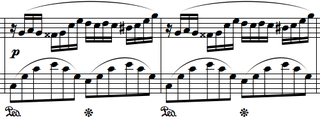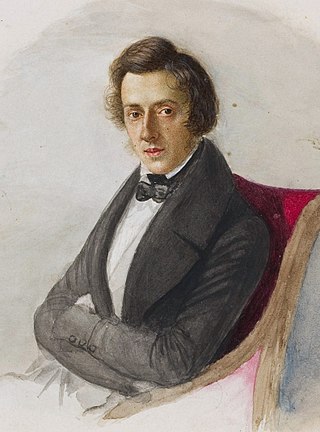
The Waltz in D-flat major, Op. 64, No. 1, sometimes known as "Valse du petit chien", and popularly known in English as the Minute Waltz, is a piano waltz by Polish composer and virtuoso Frédéric Chopin. It is dedicated to the Countess Delfina Potocka.

Karl Tausig was a Polish virtuoso pianist, arranger and composer. He is generally regarded as Franz Liszt's most distinguished pupil and one of the greatest pianists of all time.

Yundi Li, also known mononymously as Yundi, is a Chinese classical concert pianist. Yundi is especially known for his interpretation of Chopin, Liszt and Prokofiev. He is also referred as a Master in Chopin and considered one of the greatest contemporary interpreters of Chopin.

Frédéric Chopin's Fantaisie-Impromptu in C♯ minor, Op. posth. 66, WN 46 is a solo piano composition. It was composed in 1834 and published posthumously in 1855 despite Chopin's instruction that none of his unpublished manuscripts be published. The Fantaisie-Impromptu is one of Chopin's most frequently performed and popular compositions.

Ivo Pogorelić is a Croatian pianist. He is known for his sometimes unorthodox interpretations, which have brought him a sizable following and both praise and criticism from musical experts. A musician of wide repertoire, his recordings include works by a variety of composers from the early 18th through 20th centuries.

Alexis Sigismund Weissenberg was a Bulgarian-born French pianist.

The Grande valse brillante in E-flat major, Op. 18, was composed by Frédéric Chopin in 1833 and published in 1834. Chopin dedicated it to his pupil, Laura Horsford. This was his first published waltz composition for solo piano, although prior to 1834 he had written at least sixteen waltzes that were either destroyed or eventually published posthumously.

Jan Lisiecki is a Canadian-born classical pianist of Polish ancestry He performs internationally with orchestras and conductors. He has been a recording artist for Deutsche Grammophon since the age of 15. At age 18, Lisiecki was the recipient of Gramophone’s Young Artist Award and the Leonard Bernstein Award.
Frédéric Chopin's waltzes are pieces of moderate length for piano, all written between 1824 and 1849. They are all in waltz triple meter, specifically 3/4, but differ from earlier Viennese waltzes in not being intended for dancing; nonetheless, several have been used in ballets, most notably Les Sylphides. Some are accessible by pianists of modest capability, others require advanced technique.

Alice Sara Ott is a German-Japanese pianist.

Đặng Thái Sơn is a Vietnamese-Canadian classical pianist. In 1980, he won the X International Chopin Piano Competition in Warsaw, becoming the first pianist from Asia to do so. He has received particular acclaim for the sonority and poetry in his interpretations of Chopin and the French repertoire.

Daniil Olegovich Trifonov is a Russian pianist and composer. Described by The Globe and Mail as "arguably today's leading classical virtuoso" and by The Times as "without question the most astounding pianist of our age", Trifonov's honors include a Grammy Award win in 2018 and the Gramophone Classical Music Awards' Artist of the Year Award in 2016. The New York Times has noted that "few artists have burst onto the classical music scene in recent years with the incandescence" of Trifonov. He has performed as soloist with such orchestras as the Philadelphia Orchestra, New York Philharmonic, Cleveland Orchestra, Royal Philharmonic Orchestra, London Symphony Orchestra, Mariinsky Theatre Orchestra, Royal Concertgebouw Orchestra, Berlin Philharmonic, San Francisco Symphony, Montreal Symphony Orchestra, Houston Symphony and the Munich Philharmonic, and has given solo recitals in such venues as Royal Festival Hall, Carnegie Hall, John F. Kennedy Center for the Performing Arts, Berliner Philharmonie, Théâtre des Champs-Élysées, Concertgebouw, and the Seoul Arts Center.
The three Waltzes, Op. 34, were composed by Frédéric Chopin from 1834 until 1838 and published in 1838.

The three Waltzes, Op. 70, were composed by Frédéric Chopin between 1829 and 1842 and were posthumously published by Julian Fontana in 1855, six years after the composer's death. Waltz No. 1 is in G-flat major, No. 2 in F minor and No. 3 in D-flat major. Each of the three waltzes lasts less than three minutes to perform in typical performances.

Seong-Jin Cho is a South Korean pianist. He was the winner of the 2015 International Chopin Piano Competition, the first from his country. Since then, he has regularly performed as a soloist with the world's foremost orchestras.

The XVIII International Chopin Piano Competition was held from 2 to 23 October 2021 in Warsaw. Originally scheduled for 2020, the quinquennial competition was twice postponed due to the COVID-19 pandemic.

Bruce Liu is a Canadian pianist. Born in Paris and raised in Montreal, he began to play the piano at eight years old and was performing by the age of eleven. In 2021, he rose to widespread renown after winning the XVIII International Chopin Piano Competition.
Jeffrey Kallberg is an American musicologist, who specializes 19th and 20th-century classical music, as well as topics in critical theory and gender studies related to music. He is a leading scholar on the life and works of the composer Frédéric Chopin, who is the subject of much of his research.

The XIX International Chopin Piano Competition will be held from 2 to 23 October 2025 in Warsaw.
















